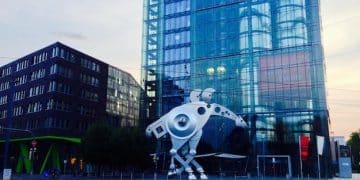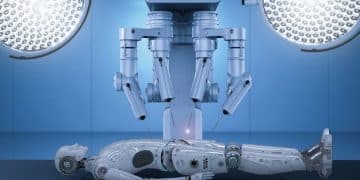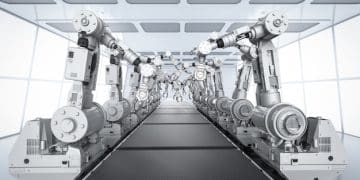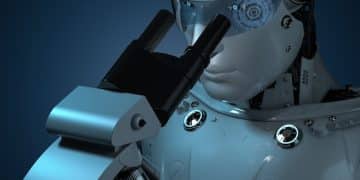Robotics Tackles US Labor Shortages by 2025: A Deep Dive
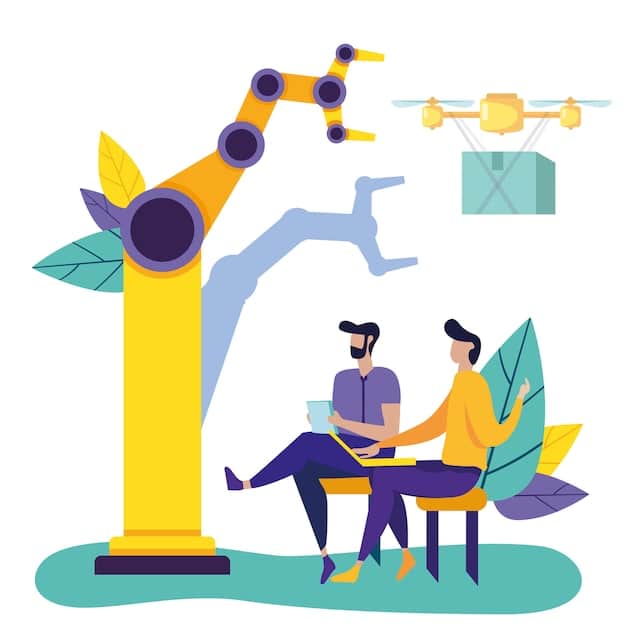
The integration of robotics is becoming a critical strategy for US companies to mitigate and overcome persistent labor shortages by 2025, automating repetitive tasks, enhancing productivity, and creating new roles that require advanced skills.
As the United States economy continues its dynamic evolution, a significant challenge persists: widespread labor shortages across numerous sectors. This isn’t merely a temporary fluctuation; it’s a structural shift impacting everything from manufacturing to healthcare. The good news? Forward-thinking US companies are increasingly turning to innovative solutions, and among these, the strategic deployment of robotics stands out as a powerful antidote. This article explores how robotics is helping US companies overcome labor shortages in 2025, transforming operations, boosting efficiency, and redefining the future workforce.
The Evolving Landscape of US Labor Shortages
The current labor market in the US is characterized by unprecedented demand outstripping supply. This phenomenon is not uniform, impacting various industries differently, but its widespread nature creates significant operational hurdles for businesses of all sizes. Understanding the multifaceted drivers behind these shortages is crucial to appreciating the role robotics plays in solving them.
Several key factors contribute to this persistent imbalance. Demographic shifts, such as an aging workforce and lower birth rates, mean fewer new entrants are joining the labor pool than those retiring. Additionally, changing worker preferences, including a desire for more flexible work arrangements and careers aligned with personal values, have reshaped employment expectations. The pandemic further exacerbated these issues, leading to shifts in industry demand and supply chains.
Demographic Shifts and Worker Preferences
The aging population is a critical demographic trend that impacts labor availability. As baby boomers retire, the pipeline of younger workers is not always sufficient to fill the void, particularly in skilled trades and physically demanding sectors. This creates a significant brain drain and a shortage of experienced personnel.
- An aging workforce leads to fewer experienced workers available.
- Younger generations seek different work-life balances.
- Demand for higher wages and improved working conditions is increasing.
- Geographic mismatches between job opportunities and available labor.
Beyond demographics, worker preferences have undergone a significant transformation. There’s a growing inclination towards remote work, flexible hours, and jobs offering better benefits and career progression. Companies that cannot adapt to these evolving expectations often struggle to attract and retain talent, compounding their labor shortage challenges. This necessitates a strategic re-evaluation of how work is performed and where technology can augment human capabilities.
Supply Chain Disruptions and Economic Volatility
Recent global events have exposed vulnerabilities in supply chains, leading to increased demand for domestic production and logistics. This surge in activity often outpaces the available skilled labor, creating bottlenecks. Companies are faced with the dilemma of either slowing production or finding alternative means to meet consumer and business needs.
Economic volatility also contributes to uncertainty. Businesses may hesitate to invest heavily in human capital during unpredictable times, leading to a leaner workforce. However, this lean approach can backfire when demand spikes, leaving companies short-handed. Robotics offers a more predictable and scalable solution, providing stability in an unstable environment and ensuring operational continuity.
Robotics as a Strategic Solution for Labor Gaps
In response to these pervasive labor shortages, US companies are increasingly embracing robotics not just as an efficiency tool, but as a fundamental solution to capacity constraints. The integration of robots is proving to be a game-changer, addressing the core issues of insufficient human labor, enhancing productivity, and allowing human workers to focus on higher-value tasks.
Robots excel at repetitive, dangerous, or physically demanding jobs that are often difficult to staff. By automating these roles, companies can reallocate their existing workforce to more complex activities, where human judgment, creativity, and problem-solving skills are indispensable. This strategic shift is not about replacing humans but augmenting them, creating a symbiotic relationship between humans and machines.
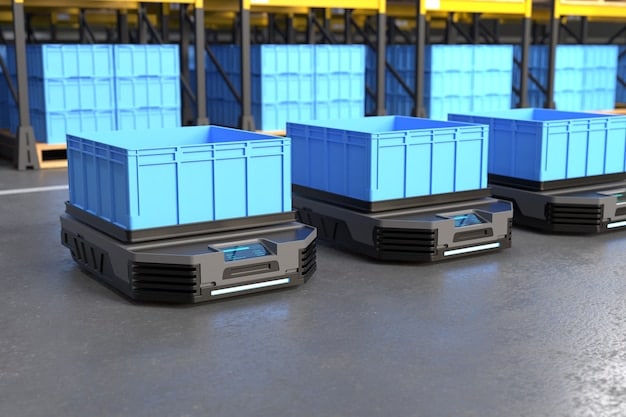
Automating Repetitive and Dangerous Tasks
Many industries, particularly manufacturing, logistics, and agriculture, rely heavily on repetitive tasks that are often monotonous and can lead to worker fatigue, errors, and injuries. These are precisely the areas where robots provide immense value, performing these jobs tirelessly and with precision.
- Loading and unloading materials in warehouses.
- Assembly line operations in factories.
- Sorting and packaging goods for distribution.
- Inspection and quality control processes.
Beyond repetition, robots are invaluable in environments that pose risks to human safety. From handling hazardous materials to working in extreme temperatures or confined spaces, robots can operate without putting human lives at risk. This not only protects employees but also reduces worker compensation claims and ensures compliance with safety regulations, making it an attractive proposition for businesses struggling to fill these challenging roles.
Boosting Productivity and Efficiency
Robotics naturally leads to significant improvements in productivity and operational efficiency. Unlike human workers, robots do not require breaks, sleep, or vacation. They can operate 24/7 without a drop in performance, maintaining consistent quality and output levels, which is crucial for meeting high production demands or tight deadlines.
The speed and accuracy of robots often surpass human capabilities in specialized tasks. For example, robotic arms can perform welds with greater consistency, or pick-and-place robots can sort items at speeds unattainable by manual labor. This increased throughput allows companies to produce more with fewer resources, directly addressing the limitations imposed by labor shortages.
Key Sectors Benefiting from Robotic Integration in 2025
While the overall trend of robotic adoption is broad, certain sectors in the US are feeling the pressure of labor shortages most acutely and are consequently seeing the most significant impact from robotic integration. These industries are leveraging automation to maintain competitiveness, expand operations, and serve their customer base effectively, demonstrating the versatility and necessity of robotics.
From the industrial backbone of manufacturing to the intricate networks of logistics and the critical services of healthcare, robots are providing tailored solutions to sector-specific challenges. This widespread adoption underscores robotics as a cross-cutting technology, adaptable to diverse operational needs and economic pressures.
Manufacturing and Industrial Production
Manufacturing has historically been at the forefront of robotic adoption, and in 2025, this trend is accelerating due to persistent shortages of skilled labor, particularly in welding, assembly, and machine operation. Robotic arms, collaborative robots (cobots), and automated guided vehicles (AGVs) are transforming shop floors.
Cobots, designed to work safely alongside humans, are bridging the gap between full automation and manual labor, enabling a more flexible and efficient production process. They assist workers with heavy lifting, repetitive tasks, and intricate assembly, freeing up human staff to supervise, troubleshoot, and innovate. This blending of human skill with robotic precision is becoming the new standard.
Logistics, Warehousing, and Supply Chain
The explosion of e-commerce has put immense pressure on logistics and warehousing operations, which often struggle with high employee turnover and a lack of available manual labor for tasks like picking, packing, and sorting. Robots are fundamentally reshaping these environments, enabling faster throughput and greater accuracy.
- Automated Storage and Retrieval Systems (AS/RS) for efficient inventory management.
- Autonomous Mobile Robots (AMRs) to move goods within warehouses.
- Robotic sorting systems for rapid parcel processing.
- Automated loading and unloading of trucks and containers.
By automating these labor-intensive activities, companies can significantly reduce their reliance on a large human workforce for basic tasks, reallocating staff to customer service, quality control, or data analysis. This optimization ensures that goods move smoothly through the supply chain, even during peak demand, proving vital for timely delivery and customer satisfaction.
Agriculture and Food Processing
The agricultural sector faces unique labor challenges, from the seasonality of work to the physical demands of harvesting. Robotics is providing innovative solutions, such as automated harvesters capable of picking delicate produce, autonomous tractors for precision farming, and robotic systems for sorting and packaging.
In food processing plants, robots are handling tasks that require high levels of hygiene and precision, like cutting, slicing, and packaging, reducing contamination risks and improving efficiency. These innovations not only address labor deficits but also significantly enhance food safety and consistency, ensuring a reliable supply of agricultural products.
Healthcare and Service Industries
While perhaps less obvious than manufacturing, healthcare and service industries are increasingly leveraging robotics to mitigate staffing issues, particularly for repetitive or physically demanding duties. In hospitals, robots assist with logistics, delivering medications and supplies, cleaning, and even performing certain surgical procedures with extreme precision.
Service industries, from hospitality to retail, are exploring robots for customer service roles, janitorial duties, and inventory management. These applications, though still evolving, show promise in freeing up human staff to provide more personalized and empathetic interactions, addressing the fundamental labor shortages in these people-centric sectors.
Challenges and Considerations in Robotic Adoption
While the benefits of robotics in addressing labor shortages are clear, the path to widespread adoption is not without its complexities. Companies must navigate a range of challenges, from significant initial investment costs to the need for a skilled workforce to manage and maintain these advanced systems. Thoughtful planning and strategic implementation are paramount for successful integration.
The transition to a more automated workforce requires a holistic approach that considers not only the technological aspects but also the human element. Addressing these challenges proactively ensures that robotics fulfills its potential as a solution to labor deficits rather than creating new problems.
Initial Investment and ROI
The upfront cost of purchasing and integrating robotic systems can be substantial, especially for small and medium-sized enterprises (SMEs). This investment includes not just the robots themselves, but also software, infrastructure modifications, training, and ongoing maintenance.
Calculating the return on investment (ROI) is crucial. While the long-term benefits of reduced labor costs, increased productivity, and improved safety are compelling, companies need a clear understanding of the payback period and how automation aligns with their financial goals. Government incentives and tax breaks for automation can help mitigate these initial financial hurdles, making adoption more feasible.
Workforce Reskilling and Training
The shift to a robotic workforce necessitates a re-evaluation of human roles. While robots take over routine tasks, new positions emerge that require different skills: programming, maintenance, supervision, and data analysis. This creates a need for significant investment in workforce reskilling and training programs.
Companies must ensure their existing employees are equipped with the knowledge and skills to work alongside robots, transforming their roles from manual labor to overseeing complex automated systems. This commitment to employee development is critical for internal acceptance and long-term success of automation initiatives, addressing potential worker anxieties about job displacement.
Integration Complexities and System Maintenance
Integrating robots into existing operational workflows can be complex, requiring careful planning and execution. Compatibility with existing machinery, software systems, and production lines must be ensured. Disruptions during the implementation phase can temporarily impact productivity.
Ongoing maintenance is another key consideration. Like any sophisticated machinery, robots require regular servicing, diagnostics, and occasional repairs to ensure continuous operation. This demands a team of skilled technicians capable of troubleshooting complex systems, adding another layer to operational costs and planning considerations for companies adopting these technologies.
The Future Workforce: Human-Robot Collaboration in 2025
Looking ahead to 2025, the picture of the American workforce increasingly includes a seamless blend of human and robotic capabilities. This isn’t a future where robots entirely replace humans, but rather one where collaboration takes center stage, fostering unprecedented levels of efficiency, innovation, and job evolution across sectors.
The concept of human-robot teaming is gaining traction, with technologies like cobots (collaborative robots) designed specifically to work safely alongside people. This partnership unlocks new possibilities for productivity and creates new, often higher-skilled, roles for human workers, redefining the nature of work itself.
Cobots and Enhanced Human Capabilities
Collaborative robots, or cobots, are at the forefront of human-robot partnerships. Unlike traditional industrial robots in cages, cobots are smaller, more flexible, and equipped with sensors that allow them to operate safely in close proximity to humans. They are designed to assist, not replace, workers in a shared workspace.
- Assisting with heavy lifting and repetitive tasks.
- Providing precision and consistency for intricate operations.
- Reducing physical strain on human workers.
- Enabling more flexible production lines and rapid retooling.
By taking on the mundane, physically demanding, or dangerous aspects of a job, cobots free up human workers to focus on tasks that require creativity, critical thinking, problem-solving, and emotional intelligence. This enhances overall human capabilities, creating a more empowering and productive work environment where human ingenuity is amplified by machine precision.
New Job Creation and Skill Evolution
While automation may displace some traditional roles, it simultaneously creates a host of new job opportunities. The demand for robot programmers, automation engineers, data analysts, AI specialists, and maintenance technicians is rapidly increasing. These are often higher-skilled, higher-paying jobs that require analytical and technical expertise.
Furthermore, many existing roles will evolve, requiring workers to adapt and acquire new skills related to overseeing automated processes, interacting with robotic systems, and leveraging data generated by smart machines. This skill evolution is crucial for maintaining a competitive workforce and ensuring that the benefits of automation are broadly distributed, rather than concentrating only among a few.
Economic Impact and Global Competitiveness
The successful integration of robotics to overcome labor shortages will have a profound economic impact on the US. By maintaining and even increasing production despite a shrinking human labor pool, companies can avoid lost revenue, meet consumer demand, and strengthen their position in global markets.
Increased domestic automation also reduces reliance on complex global supply chains and foreign labor, enhancing national resilience and economic stability. This strategic move towards self-sufficiency and efficiency through robotics positions US companies favorably in an increasingly competitive international landscape, ensuring sustained growth and innovation.
| Key Point | Brief Description |
|---|---|
| 🔄 Labor Gap Solution | Robotics directly addresses chronic US labor shortages by automating repetitive and hazardous tasks across various sectors. |
| ⚙️ Productivity Boost | Robots enhance operational efficiency, increase throughput, and ensure consistent quality, operating 24/7. |
| 🤝 Human-Robot Collaboration | Cobots enable safe co-working, freeing humans for higher-value activities and fostering new skill development. |
| 📈 Economic Resilience | Wider robotic adoption strengthens domestic production, reduces supply chain vulnerabilities, and boosts global competitiveness. |
Frequently Asked Questions
▼
Robotics primarily addresses shortages in repetitive, physically demanding, or hazardous roles across sectors like manufacturing (welding, assembly), logistics (picking, packing), healthcare (material transport), and agriculture (harvesting). These are often roles with high turnover or difficulty in attracting adequate skilled labor, where automation provides a consistent solution.
▼
While robots automate some tasks, the broader trend indicates job transformation and creation. Robots take over monotonous or dangerous work, allowing humans to focus on higher-value tasks, creativity, and problem-solving. This shift creates new demand for roles like robot programmers, maintenance technicians, and automation specialists, requiring workforce reskilling.
▼
Cobots, or collaborative robots, are designed to work safely alongside human employees in a shared workspace. They differ from traditional industrial robots by their smaller size, flexibility, and safety features. Cobots enhance human capabilities by assisting with heavy lifting, repetitive tasks, and precision work, fostering a collaborative environment that boosts efficiency and protects workers.
▼
The initial investment for robotics can be significant, covering hardware, software, integration, and training. Companies manage this by performing thorough ROI calculations, often finding long-term savings in reduced labor costs and increased productivity. Government incentives, tax breaks, and strategic financing can also help mitigate the initial financial burden for businesses.
▼
By overcoming labor shortages, robotics allows US companies to maintain and increase production, reducing reliance on foreign labor and bolstering domestic supply chains. This enhances economic resilience and ensures companies can meet demand, strengthening their position in global markets. Improved efficiency and output contribute to sustained economic growth and innovation across various sectors.
Shaping the Workforce of Tomorrow
The persistent challenge of labor shortages in the United States is prompting a fundamental re-evaluation of how businesses operate. From manufacturing to logistics, healthcare to agriculture, the integration of robotics is no longer a futuristic concept but a tangible, strategic imperative. By 2025, robots are not merely supplementing human labor; they are becoming an integral part of the operational machinery, enabling companies to sustain productivity, innovate, and maintain competitiveness in a dynamically changing global economy.
This evolution underscores a future where human ingenuity and robotic efficiency converge. It’s a landscape where new skill sets emerge, fostering an adaptive workforce capable of harnessing advanced technologies. As US companies navigate the complexities of talent acquisition and retention, robotics offers a powerful, scalable, and increasingly accessible solution, promising not just to fill immediate gaps but to redefine the very foundations of the American industrial and service landscape for years to come.
